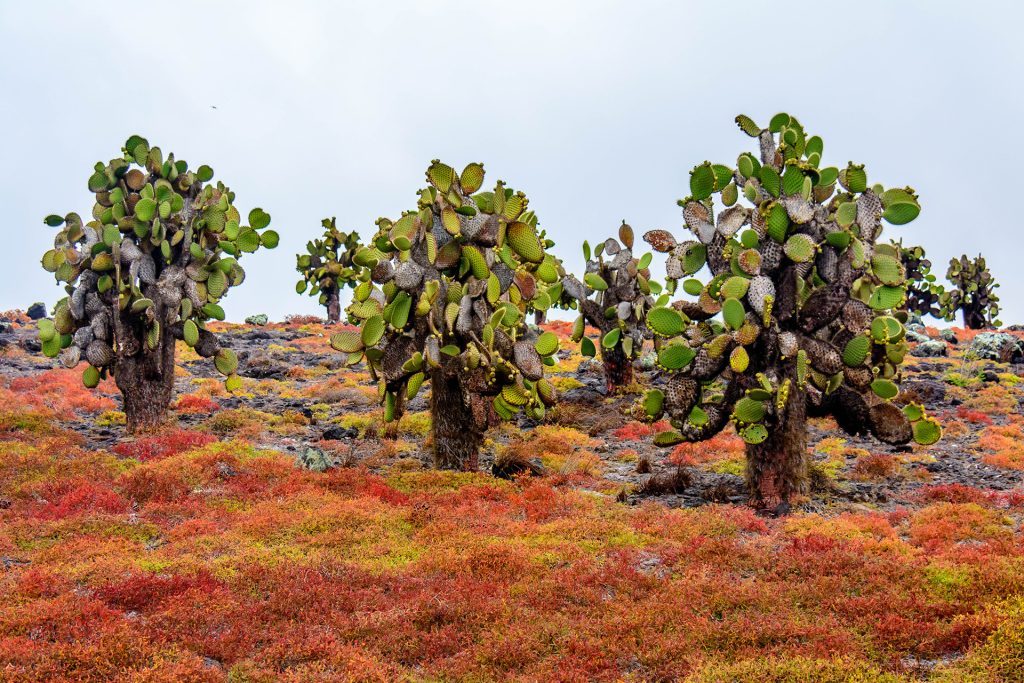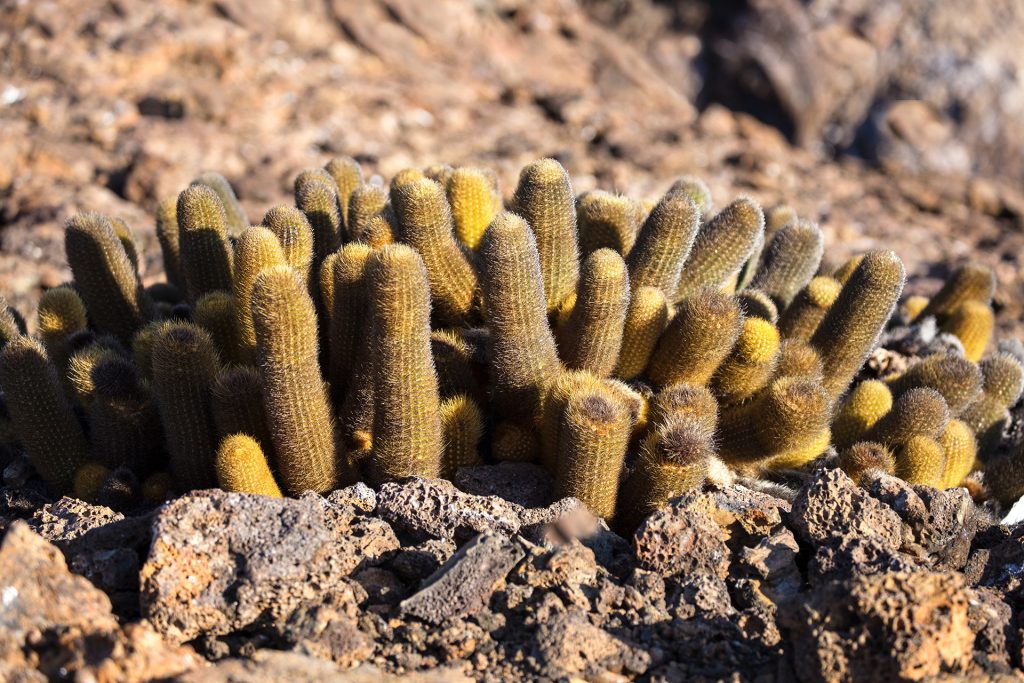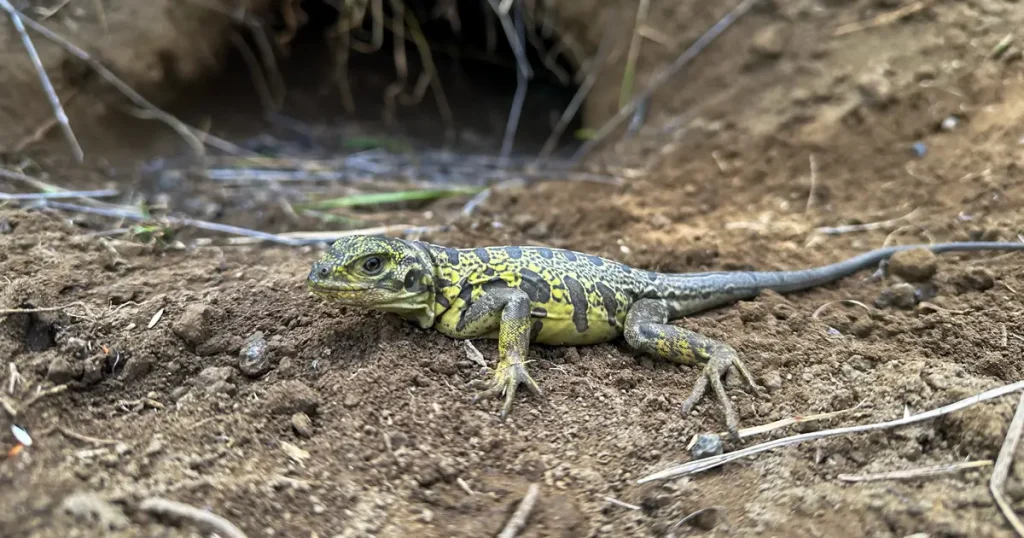Discovering Galápagos Cacti and Their Resilient Beauty
Date: 7/18/2023

In the remote and magical Galápagos Archipelago, cacti majestically rise from volcanic rocks and arid soil as silent witnesses to life in its most resilient form. These unique species have conquered the islands’ challenging landscapes and lava fields, adapting and surviving over the years. In this story, we delve into the fascinating world of Galápagos cacti, uncovering a captivating narrative of survival and an extraordinary diversity of species. The wide range of endemic cacti exclusive to this region creates a perfect stage to marvel at their beauty and adaptability.
Among the most emblematic species of Galápagos are the Opuntia Cactus (Opuntia spp.), also known as the Galápagos Tuna. Its flat, green cladodes (large pads) and juicy fruits are remarkable adaptations for survival in the arid conditions of different islands in the archipelago. These species are endemic to Galápagos, and that vary from island to island, play a vital role in the ecosystem, providing food and shelter for various species of birds, land iguanas, and giant tortoises.
Lava cacti (Brachycereus nesioticus) are another example of endemic cacti in Galápagos. These short plants with clumps of cylindrical stems are found in the archipelago’s youngest islands and have developed special adaptations to survive and thrive in inhospitable volcanic landscapes, despite the lack of organic soil and periods of drought. Lava cacti are one of the first species to colonize a recent lava flow, paving the way for the introduction of other plant species.
The Galápagos Candelabra Cactus (Jasminocereus thouarsii) is also a standout endemic species in the Enchanted Islands. Its distinctive candelabra-like shape allows it to survive in arid and rocky environments by storing water in its stems. This cactus is an iconic symbol of Galápagos and a vital resource for various bird species, such as Darwin’s finches and the Galápagos Dove, which find refuge and food in it.
The Opuntia Cactus is found across various islands of the Galápagos and has evolved unique adaptations to thrive within its ecosystem. ©Lawrence Conaway
Conservation of endemic cactus species in Galápagos is critical to maintaining the natural ecological dynamics of the islands. These unique plants play an essential role in ecosystems by providing sustenance and vital support to a wide variety of life forms. Their adaptive characteristics for withstanding challenging island conditions, such as the ability to store water in their tissues for months, enable them to serve as pioneer umbrella species in colonizing lava fields and, in turn, facilitate new life. Conserving these endemic cactus species ensures the continuity of the archipelago’s intricate ecological webs.
As we delve into the fascinating array of Galápagos cacti, we are amazed by their admirable adaptability and exquisite beauty. Their presence on different islands is a constant reminder of the urgent need to protect and conserve the extraordinary biodiversity of Galápagos. These succulents, in all their captivating forms, share an ability to survive in extreme conditions, teaching us the valuable lesson of resilience and the interconnection of life on these islands. As guardians of this natural legacy, we must ensure these species continue to flourish in their natural habitats for the delight and benefit of future generations.

Descubriendo los Cactus de Galápagos y su Resiliente Belleza
En el remoto y mágico Archipiélago de Galápagos, los cactus se alzan como majestuosos y silenciosos testigos de la vida en su forma más resistente. Estas singulares especies han conquistado los desafiantes paisajes y campos volcánicos de las islas, adaptándose y sobreviviendo a lo largo de los años.
En esta historia, nos sumergimos en el fascinante mundo de los cactus de Galápagos, donde descubrimos una apasionante narrativa sobre la supervivencia y la extraordinaria diversidad de estas especies únicas. Galápagos alberga una amplia gama de cactus endémicos, lo que significa que son exclusivos de esta región en particular, creando un escenario perfecto para maravillarnos con su belleza y adaptabilidad.
Entre las especies más emblemáticas de Galápagos están las del Cactus Opuntia (Opuntia spp.), también conocido como Tuna de Galápagos. Sus grandes y aplanados cladodios verdes y sus frutos jugosos son una adaptación notable para sobrevivir en las condiciones áridas de las diferentes islas. Estas especies son endémicas de Galápagos, varían de una isla a otra y desempeñan un papel vital en los ecosistemas, proporcionando alimento y refugio para diversas especies de aves, iguanas terrestres y tortugas gigantes.
Los cactus de lava (Brachycereus nesioticus) son otro ejemplo de cactus endémicos de Galápagos. Estas plantas se encuentran en las islas más jóvenes del archipiélago y han desarrollado adaptaciones especiales para sobrevivir en los inhóspitos parajes volcánicos. A pesar de la falta de suelo orgánico y los drásticos períodos de sequía, los cactus de lava han logrado prosperar gracias a sus singulares adaptaciones.
También se destaca el Cactus Candelabro (Jasminocereus thouarsii), otra especie endémica y emblemática del archipiélago, cuya forma distintiva, similar a un candelabro, le permite sobrevivir en entornos áridos y rocosos, almacenando agua en sus tallos.
Este cactus no solo es un símbolo icónico de Galápagos, sino un recurso importante para diversas especies de aves, como los pinzones de Darwin y palomas de Galápagos que encuentran refugio y alimento en él.
Es de suma importancia destacar la importancia de conservar las especies de cactus endémicos de Galápagos, para mantener la dinámica natural de los ecosistemas. Estas plantas únicas son ecológicamente esenciales, debido a que proporcionan sustento y apoyo vital a una amplia variedad de formas de vida. Sus características adaptativas, como la capacidad de almacenar agua en sus tejidos y resistir las condiciones áridas y desafiantes del entorno insular, los convierten en especies pioneras para colonizar los campos de lava y a su vez servir como especies paraguas. La conservación de estas especies de cactus garantiza la continuidad de las complejas tramas ecológicas del archipiélago.
Al adentrarnos en la historia de los cactus de Galápagos, quedamos asombrados por su admirable adaptabilidad y la exquisita belleza que exhiben. Su presencia en las diferentes islas es un constante recordatorio de la necesidad imperante de proteger y conservar la extraordinaria biodiversidad de Galápagos. Con sus formas únicas y su capacidad para sobrevivir en condiciones extremas, nos enseñan la valiosa lección de la resiliencia y la interconexión de la vida en estos entornos insulares. Como guardianes de este legado natural, es nuestra responsabilidad asegurar que estas especies continúen floreciendo y prosperando en su entorno natural, para el deleite y beneficio de las presentes y futuras generaciones.



